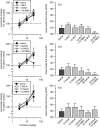The effects of repeated opioid administration on locomotor activity: II. Unidirectional cross-sensitization to cocaine
- PMID: 19403852
- PMCID: PMC2713084
- DOI: 10.1124/jpet.108.150037
The effects of repeated opioid administration on locomotor activity: II. Unidirectional cross-sensitization to cocaine
Abstract
Sensitization refers to an increase in sensitivity to the effects of a drug and is believed to play a role in the etiology of substance use disorders. Cross-sensitization has been observed between drugs from different pharmacological classes and may play a role in the escalation of drug use in polydrug-abusing populations. The purpose of this study was to examine cross-sensitization between opioids and cocaine and to determine the extent to which cross-sensitization is mediated by an opioid's selectivity for mu, kappa, and delta receptors. Separate groups of rats were treated with opioid receptor agonists and antagonists every other day for 10 days, and the locomotor effects of cocaine were tested 8 days later. The mu agonists, morphine and buprenorphine, and the delta agonist, BW373U86 [(+/-)-4-[(R(*))-[(2S(*),5R(*))-2,5-dimethyl-4-(2-propenyl)-1-piperazinyl]-(3-hydroxyphenyl)methyl]-N,N-diethylbenzamide hydrochloride], produced cross-sensitization to cocaine, such that repeated administration of these drugs over a 10-day period significantly enhanced cocaine's locomotor effects when tested later. Coadministration of the opioid antagonist naltrexone prevented morphine and buprenorphine from producing cross-sensitization. Coadministration of naltrexone, but not the delta antagonist naltrindole, also prevented BW373U86 from producing cross-sensitization. The kappa agonist spiradoline failed to produce cross-sensitization, but coadministration of spiradoline prevented morphine and buprenorphine from producing cross-sensitization. The ability of spiradoline to block cross-sensitization was itself blocked by the kappa antagonist nor-binaltorphimine. The mixed mu/kappa opioids butorphanol, nalbuphine, and nalorphine did not produce cross-sensitization under any condition examined. These data indicate that agonist activity at mu receptors positively modulates cross-sensitization between opioids and cocaine, whereas agonist activity at kappa receptors negatively modulates this effect.
Figures








Similar articles
-
The effects of repeated opioid administration on locomotor activity: I. Opposing actions of mu and kappa receptors.J Pharmacol Exp Ther. 2009 Aug;330(2):468-75. doi: 10.1124/jpet.108.150011. Epub 2009 Apr 29. J Pharmacol Exp Ther. 2009. PMID: 19403853 Free PMC article.
-
Interactions between opioids and cocaine on locomotor activity in rats: influence of an opioid's relative efficacy at the mu receptor.Psychopharmacology (Berl). 2003 May;167(3):265-73. doi: 10.1007/s00213-003-1388-z. Epub 2003 Apr 1. Psychopharmacology (Berl). 2003. PMID: 12669175
-
Discriminative stimulus effects of the mixed-opioid agonist/antagonist dezocine: cross-substitution by mu and delta opioid agonists.J Pharmacol Exp Ther. 1997 Dec;283(3):1009-17. J Pharmacol Exp Ther. 1997. PMID: 9399970
-
Interactions between kappa opioid agonists and cocaine. Preclinical studies.Ann N Y Acad Sci. 2000;909:104-32. doi: 10.1111/j.1749-6632.2000.tb06678.x. Ann N Y Acad Sci. 2000. PMID: 10911926 Review.
-
Mixed κ/μ partial opioid agonists as potential treatments for cocaine dependence.Adv Pharmacol. 2014;69:387-418. doi: 10.1016/B978-0-12-420118-7.00010-X. Adv Pharmacol. 2014. PMID: 24484983 Review.
Cited by
-
Effects of alcohol preload on attentional bias towards cocaine-related cues.Psychopharmacology (Berl). 2010 Jun;210(3):365-75. doi: 10.1007/s00213-010-1830-y. Epub 2010 Mar 30. Psychopharmacology (Berl). 2010. PMID: 20352412
-
Early Life Stress as a Risk Factor for Substance use Disorders: Clinical and Neurobiological Substrates.Indian J Psychol Med. 2015 Jan-Mar;37(1):36-41. doi: 10.4103/0253-7176.150816. Indian J Psychol Med. 2015. PMID: 25722510 Free PMC article.
-
The mu/kappa agonist nalbuphine attenuates sensitization to the behavioral effects of cocaine.Pharmacol Biochem Behav. 2013 Mar;104:40-6. doi: 10.1016/j.pbb.2012.12.026. Epub 2013 Jan 7. Pharmacol Biochem Behav. 2013. PMID: 23305678 Free PMC article.
-
One-trial cocaine-induced behavioral sensitization in preweanling rats: role of contextual stimuli.Exp Clin Psychopharmacol. 2010 Jun;18(3):284-95. doi: 10.1037/a0019142. Exp Clin Psychopharmacol. 2010. PMID: 20545393 Free PMC article. Clinical Trial.
-
Effects of Cebranopadol on Cocaine-induced Hyperactivity and Cocaine Pharmacokinetics in Rats.Sci Rep. 2020 Jun 9;10(1):9254. doi: 10.1038/s41598-020-66250-z. Sci Rep. 2020. PMID: 32518276 Free PMC article.
References
-
- Beyer CE and Steketee JD (2001) Characterization of the role of medial prefrontal cortex dopamine receptors in cocaine-induced locomotor activity. Behav Neurosci 115 1093-1100. - PubMed
-
- Bowen CA, Negus SS, Zong R, Neumeyer JL, Bidlack JM, and Mello NK (2003) Effects of mixed-action kappa/mu opioids on cocaine self-administration and cocaine discrimination by rhesus monkeys. Neuropsychopharmacology 28 1125-1139. - PubMed
-
- Chang KJ, Rigdon GC, Howard JL, and McNutt RW (1993) A novel, potent and selective nonpeptidic delta opioid receptor agonist BW373U86. J Pharmacol Exp Ther 267 852-857. - PubMed
-
- Crombag HS, Jedynak JP, Redmond K, Robinson TE, and Hope BT (2002) Locomotor sensitization to cocaine is associated with increased Fos expression in the accumbens, but not in the caudate. Behav Brain Res 136 455-462. - PubMed
-
- Cunningham ST, Finn M, and Kelley AE (1997) Sensitization of the locomotor response to psychostimulants after repeated opiate exposure: role of the nucleus accumbens. Neuropsychopharmacology 16 147-155. - PubMed
Publication types
MeSH terms
Substances
Grants and funding
LinkOut - more resources
Full Text Sources
Research Materials

